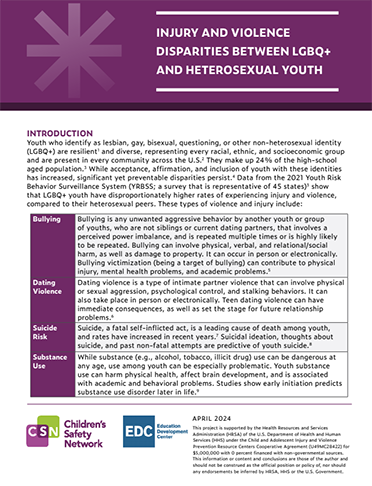
Youth who identify as lesbian, gay, bisexual, questioning, or other non-heterosexual identity (LGBQ+) are resilient1 and diverse, representing every racial, ethnic, and socioeconomic group and are present in every community across the U.S.2 They make up 24% of the high-school aged population.3 While acceptance, affirmation, and inclusion of youth with these identities has increased, significant yet preventable disparities persist.4 Data from the 2021 Youth Risk Behavior Surveillance System (YRBSS; a survey that is representative of 45 states)3 show that LGBQ+ youth have disproportionately higher rates of experiencing injury and violence, compared to their heterosexual peers.
In Children's Safety Network's new fact sheet, learn more about injury and violence disparities between LGBQ+ and heterosexual youth, risk factors that help us understand these disparities, and protective factors that can prevent these disparities.
Download a PDF of the fact sheet for printing
_____
1Lira, A. N., & Morais, N. A. (2018). Resilience in lesbian, gay, and bisexual (LGB) populations: An integrative literature review. Sexuality Research and Social Policy: A Journal of the NSRC, 15(3), 272–282. https://doi.org/10.1007/s13178-017-0285-x
2Centers for Disease Control and Prevention. (2019). Health considerations for LGBTQ youth. https://www.cdc.gov/healthyyouth/disparities/health-considerations-lgbtq-youth.htm
3Centers for Disease Control and Prevention. 2021 Youth Risk Behavior Survey Data. Available at: http://www.cdc.gov/yrbs. Accessed on January 23, 2024.
4Russell, S. T. & Fish, J. N. (2019). Sexual minority youth, social change, and health: A developmental collision. Research in Human Development, 16(1), 5-20. https://doi.org/10.1080/15427609.2018.1537772